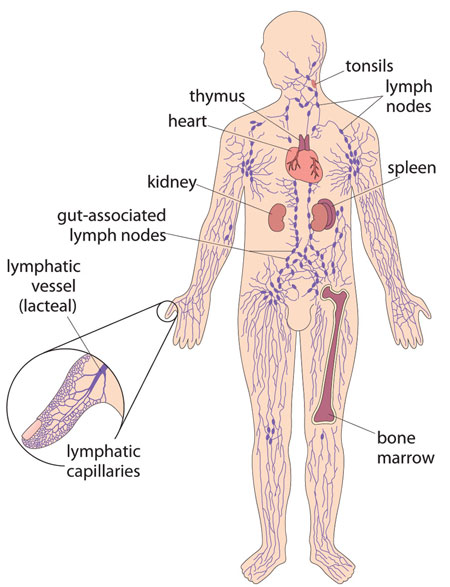20.2.2 The human immune system
The immune system is a collection of cells, tissues and organs in the human body, with the combined function of protecting us against invasion by infectious agents (see Figure 20.3). In the absence of an effective immune system, our bodies would easily be invaded by pathogenic (disease-causing) viruses, bacteria, protozoa and parasites, which would rapidly cause our death. The exact functioning of the immune system is very complex, and explaining it in detail would go beyond the scope of this Module. Rather, we will focus here on a particular aspect of the immune system, so that you can understand what HIV does to the human body once it gets inside us.

Biologists and doctors use the term ‘leukocytes’ instead of white blood cells; we will use both terms in this study session. You will probably say ‘white blood cells’ when talking to your clients.
The immune system first recognises infectious agents as not being a normal part of the body, or, in other words, ‘foreign’ to the body. Then the cells of the immune system organise a concerted attack against the infectious agents in order to destroy them. These immune cells are most often known as white blood cells — although the name is misleading because they are found throughout the body’s tissues and organs, as well as in the blood, as Figure 20.3 shows. There are several different types of white blood cells, and we will say more about one of them shortly.
The immune response by a person’s white blood cells takes a few days to build up during the first time that a particular type of infectious agent gets into his or her body. During this delay, there is usually time for the infectious agents to multiply and cause symptoms of the illness. However, as the immune attack builds up, it may become strong enough to eliminate the infection, and the person recovers spontaneously from a so-called self-limiting infection. But in some types of infection, the immune response cannot protect the person sufficiently from the infectious agents, they become more and more ill, and without medical intervention they may eventually die. This is what happens in PLHIV unless they receive modern medical treatments.
One important feature of the immune system is that it very quickly recognises the same infectious agents if they have invaded that individual in the past. This is known as immunological memory. It enables the immune system to organise a stronger, faster and more efficient attack if it comes across the same infectious agent again in the future. You will see later that the immune system manages to keep HIV under control for months or years after it first invades the body, but eventually it becomes overwhelmed by the virus.
20.2.1 What is HIV?
